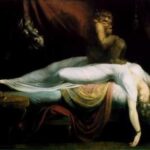Have you ever heard of the Hag Syndrome? Well this is what Dream Paralysis was once called. Some people believe that the origins of this syndrome may be rooted in the incubus and succubus legends. Also, from the Scandinavian, and Icelandic legends the origins might also come from the Mara, or Mare, who is responsible for nightmares. Dream Paralysis is associated with terrible nightmares where the devil sits on a person’s chest at night.
Dream Paralysis otherwise known as Sleep Paralysis is a sleep disorder that affects more individuals then you would think. Though not usually a chronic condition, sleep paralysis can occur at least once in about 80% of the population.
These nightmares are usually described as lying awake at night, being unable to move with a heavy force weighing down on the chest. This force usually takes on a sinister form, like a demon, ghoul or hooded figure. The feelings are so vivid and so real that the sufferers can recount every little detail and sensation of the nightmare long after fully awake and fully conscious.
Other folklore surrounding Sleep Paralysis
In the African culture it is known as the witch riding your back.
“In the Cambodian, Laotian and Thai culture, Sleep Paralysis is referred to as “pee umm” and “khmout sukkhot”. It describes an event where the person is sleeping and dreams that ghostly figure(s) are either holding him/her down or the ghosts can just be near. The person usually thinks that they are awake but is unable to move or make any noises. This is not to be confused with “pee khao” and “khmout jool” which refers to a ghost possession.”
In the Hmong culture (people living in Southeast Asia, Laos, Viet Nam, Thailand and Burma) it is known as “dab tsog” or “crushing demon.”
In Vietnamese culture it is known as “ma đè”, meaning “held down by a ghost” or “bóng đè”, meaning “held down by a shadow”. Many people in this culture believe that a ghost has entered one’s body, causing the paralyzed state.”
The Chinese called it ghost pressing on the body.
In Japanese culture is called kanashibari, meaning bound or fastened in metal.
In Maltese culture it is called the attack of the haddiela, which is similar to a poltergeist. To rid the dreamer of the haddiela the sufferer places a knife under his or her pillow.
Turkish people called it the mottaka, and this ghost appears if the person has done something bad.
In New Guinea they called it “Suk Ninmyo” and they believe it is sacred trees that attack the human at night to sap the body of its essence.
In Turkish culture it is the “karabasan” an assailant that presses on the chest and robs the breath of the victim.
In Mexico it is known as “se me subió el muerto, and it is the dead pressing on the chest of the dreaming person.
See the wikipedia article below for more references.
Symptoms of Sleep Paralysis
– Vibrations and shaking
– Catalepsy (loss of muscle tone)
– Hypnagogia (a state between being awake and being asleep)
– The sensation of floating, as in “out of body”
– The sense that other beings are in the room or vicinity
– The ability to see through closed eyes.
Note: It appears that the sufferer is acting out the dream in a conscious but not a physical capacity.
What can trigger Sleep Paralysis Disorder?
Stress
Life changes
Some people experience this condition when trying to induce lucid dreaming.
What causes Dream Paralysis?
This condition is often associated with narcolepsy (daytime sleeping or falling asleep at inappropriate times). It is also associated with epilepsy.
The leading theory is that a chemical malfunction that occurs in the Pons area of the brain stem during the REM (Rapid Eye Movement) Phase of sleep which causes the sleep paralysis. Normally during REM sleep we try to act out our dreams and the chemical produces the paralysis to avoid being hurt, however with Sleep Paralysis Disorder, the individual leaves the REM phase, and is awake but the chemical has not yet worn off and so the individual still cannot move. Medically speaking there seems to be low levels of melatonin, which inhibits the brain from stimulating the motor neurons to return to fully functional upon wakening. This is when the individual in question is subject to both visual and auditory hallucinations and for the brief period that it is happening it is really terrifying.
The Sensed Presence Theory has to do with the right and left hemisphere of the brain. The dominant hemisphere is the left hemisphere, which expresses language and logic. The right hemisphere is expressed in symbols. In this theory it is believed that the right hemisphere takes over and it is experienced as an outside the body experience, images are cloudy, dark and scary and people sense they are not alone, someone or something is watching them. It is also considered to be a split-brain theory.
Another stranger theory for Sleep Paralysis has to do with astral travel or out of body experiences. When we dream we leave our bodies to travel the astral plane. While our souls have left our bodies, it is possible for something in this real world or this realm to hold us down. I am not quite sure how that works though.
Still there is another theory that during Sleep Paralysis the mind has separated from the physical body but is in the etheric stage (not yet in astral travel).
All these theories are fascinating but quite frightening for the person experiencing them. Try to remain calm if they occur and if it happens more than once please consult your physician immediately.
Sources:
http://en.wikipedia.org/wiki/Sleep_paralysis
http://www.astralvoyage.com/projection/Catatonic.html
http://www.shaktitechnology.com/sp.htm
http://www.bellaonline.com/articles/art29750.asp




